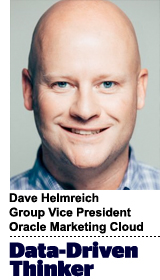
“Data-Driven Thinking” is written by members of the media community and contains fresh ideas on the digital revolution in media.
Today’s column is written by Dave Helmreich, group vice president at Oracle Marketing Cloud.
Earlier this decade, digital media platforms transitioned from interesting ways for people to stay in touch with old friends and keep up with news to a critical vehicle for businesses to reach their customers. Built into these platforms were ways for brands to address customers and prospects directly, leveraging data and coining the term, people-based marketing.
With that change came the need for technology experts with a deep understanding of both advertising and marketing. And now, thanks to the massive amounts of brand-created first party data to improve the personalization and profitability of customer and prospect interactions, these digital platforms have become a critical aspect of business.
To succeed, there are some skills workers must embrace. First, all marketers should already be comfortable working with new reporting and analytics tools, especially automated ones. Machine intelligence operates at great scale and can provide huge time savings and increase the velocity of team learning. Even more importantly, machines analyze the data from traditional and digital sources at a speed humans never could.
Machine learning platforms aren’t the only new tools marketers need to be familiar with. Today most organizations use 30 to 40 analytics tools for things like search, SEO and social. Cisco has publicly shared its technology stack, which has 39 solutions providers across customers, partners, sales and data and operations.
To drive growth, companies must consolidate these portfolios and find solutions that provide useful data around cost of customer attention and other factors that help drive integration and understand the customer journey. These holistic tools are core to the modern marketing organization and it’s critical that all team members know how to leverage them.
The modern marketer also needs to be comfortable with measurement. That doesn’t mean everyone in a marketing department needs a degree in statistics in order to take a measurement-first mindset, but, companies who can integrate trained data scientists into their existing marketing teams will be more successful at driving high ROMI numbers from their marketing functions. On the flip side, companies who don’t have specialized number crunchers, or data scientists, struggle to compete.
With team training to develop better data judgement and decision making ability – and a common language around such data use – an organization can improve the accuracy of forecasting by up to 83%. With data democratization, the adage of “half of the investment marketing/advertising is wasted” decreases amidst greater transparency.
The rise of digital media and increased access to customer data has closed the gap between technologists and marketers. The companies that will succeed in the digital age are the ones that unite data across marketing and advertising spend, create feedback loops that leverage insights to drive change, and train employees to be both marketers and technologists.
Follow Oracle Marketing Cloud (@OracleMktgCloud) and AdExchanger (@adexchanger) on Twitter.
This post was syndicated from Ad Exchanger.


More Stories
Thursday, Feb. 20 Evening Cable News Ratings: The Five Is 1st in Total Viewers
Meta and X Approve AI Ads Referencing Nazi War Crimes Ahead of German Elections, Research Finds
X Rolls Out AI-Generated Ads in Push to Win Advertisers Back